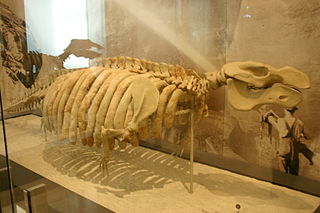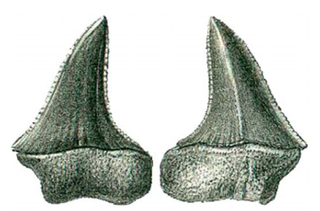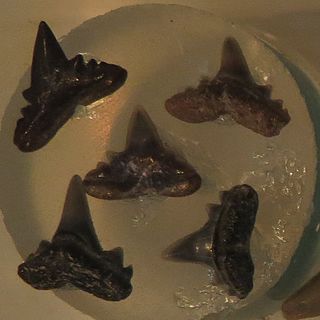
The megamouth shark is a species of deepwater shark. Rarely seen by humans, it measures around 5.2 m (17 ft) long and is the smallest of the three extant filter-feeding sharks alongside the relatively larger whale shark and basking shark. According to Sharkman's World Organization a total of 286 specimens have been observed or caught since its discovery in 1976, Like the other two planktivorous sharks, it swims with its mouth wide open, filtering water for plankton and jellyfish. It is recognizable from its large head with rubbery lips. The megamouth is so unlike any other type of shark that it is usually considered to be the sole extant species in the family Megachasmidae, though some scientists have suggested it may belong in the family Cetorhinidae.

Carcharodon is a genus of sharks within the family Lamnidae, colloquially called the "white sharks." The only extant member is the great white shark. The extant species was preceded by a number of fossil (extinct) species including C. hubbelli and C. hastalis. The first appearance of the genus may have been as early as the Early Miocene or Late Oligocene. Carcharocles megalodon is still argued by some paleontologists to be a close relative of Carcharodon carcharias - as well as being in the same genus. The megalodon's scientific name was originally 'Carcharodon' megalodon, but more recently, the giant shark has been assigned by most scientists to either the genus Carcharocles or Otodus.

Otodus megalodon, commonly known as a megalodon, is an extinct species of giant mackerel shark that lived approximately 23 to 3.6 million years ago (Mya), from the Early Miocene to the Pliocene epochs. O. megalodon was formerly thought to be a member of the family Lamnidae and a close relative of the great white shark, but has been reclassified into the extinct family Otodontidae, which diverged from the great white shark during the Early Cretaceous.

Squalodon is an extinct genus of whales of the Oligocene and Miocene epochs, belonging to the family Squalodontidae. Named by Jean-Pierre Sylvestre de Grateloup in 1840, it was originally believed to be an iguanodontid dinosaur but has since been reclassified. The name Squalodon comes from Squalus, a genus of shark. As a result, its name means "shark tooth". Its closest modern relative is the South Asian river dolphin.

Wakaleo is an extinct genus of medium-sized thylacoleonids that lived in Australia in the Late Oligocene and Miocene Epochs.

Carcharias is a genus of mackerel sharks belonging to the family Odontaspididae. Once bearing many prehistoric species, all have gone extinct with the exception of the critically endangered sand tiger shark.

Otodus angustidens is an extinct species of prehistoric megatoothed sharks in the genus Otodus, which lived during the Oligocene and Miocene epochs about 33 to 22 million years ago. The largest individuals were about 11–12 metres (36–39 ft) long. This shark is related to another extinct megatoothed shark, the famous Otodus megalodon.

Metaxytherium is an extinct genus of dugong that lived from the Oligocene until the end of the Pliocene. Fossil remains have been found in Africa, Europe, North America and South America. Generally marine seagrass specialists, they inhabited the warm and shallow waters of the Paratethys, Mediterranean, Caribbean Sea and Pacific coastline. American species of Metaxytherium are considered to be ancestral to the North Pacific family Hydrodamalinae, which includes the giant Steller's sea cow.

Brygmophyseter, known as the biting sperm whale, is an extinct genus of toothed whale in the sperm whale family with one species, B. shigensis. When it was first described in 1994, the species was placed in the genus Scaldicetus based on tooth morphology, but this was later revised in 1995. In 2006, it was classified into the genus Naganocetus, which is considered to be a junior synonym. The only known specimen, a nearly complete skeleton, was dated to be around 16–15 million years old. Brygmophyseter is thought to have been 6.5–7 meters (21–23 ft) long, and it probably had 11 or 12 teeth in the upper and lower jaws. Brygmophyseter is part of a group of macroraptorial sperm whales which tended to be apex predators using their large teeth to catch struggling prey such as whales. It had a spermaceti organ which was probably used for biosonar like in the modern sperm whale. The whale has made an appearance on The History Channel's TV series Jurassic Fight Club.

Cylindracanthus is an extinct, enigmatic genus of marine ray-finned fish with fossils known throughout North America, Europe, Asia and Africa from the Late Cretaceous to the late Eocene, with potential Oligocene records and a possible Miocene record also known. It is exclusively known from its distinctive partial remains, which are long cylindrical bony spines that are usually considered rostrum fragments, as well as some associated teeth. These spines are abundant & widespread throughout this timespan, and are useful indicators of a nearshore marine environment, but the taxonomic identity of the fish is still highly uncertain and debated.

Diomedeoides is a prehistoric genus of seabirds. The family was in the order Procellariiformes which today is composed of the albatrosses and petrels. At present it is the only genus in the family Diomedeoididae. There are three described species. The taxonomy of the family and genus is still in need to revision, and it is likely that the genus name Diomedeoides is actually the junior synonym to Rupelornis.

Otodus chubutensis, meaning "ear-shaped tooth of Chubut", from Ancient Greek ὠτ and ὀδούς – thus, "ear-shaped tooth", is an extinct species of prehistoric megatoothed sharks in the genus Otodus, that lived during Early Miocene to Middle Miocene. The largest individuals were about 13.5 metres (44 ft) long. This shark is considered a close relative of the famous prehistoric megatoothed shark O. megalodon. However, as is the case with O. megalodon, the classification of this species is disputed.

Livyatan is an extinct genus of macroraptorial sperm whale containing one known species: L. melvillei. The genus name was inspired by the biblical sea monster Leviathan, and the species name by Herman Melville, the author of the famous novel Moby-Dick about a white bull sperm whale. Herman Melville often referred to whales as "Leviathans" in his book. It is mainly known from the Pisco Formation of Peru during the Tortonian stage of the Miocene epoch, about 9.9–8.9 million years ago (mya); however, finds of isolated teeth from other locations such as Chile, Argentina, the United States (California), South Africa and Australia imply that either it or a close relative survived into the Pliocene, around 5 mya, and may have had a global presence. It was a member of a group of macroraptorial sperm whales and was probably an apex predator, preying on whales, seals and so forth. Characteristically of raptorial sperm whales, Livyatan had functional, enamel-coated teeth on the upper and lower jaws, as well as several features suitable for hunting large prey.

Thecachampsa is an extinct genus of gavialoid crocodylian, traditionally regarded as a member of the subfamily Tomistominae. Fossils have been found from the eastern United States in deposits of Miocene age. Those named in the 19th century were distinguished primarily by the shape of their teeth, and have since been combined with T. antiquus. More recently erected species were reassigned from other genera, although their assignment to Thecachampsa has since been questioned.

Cosmopolitodus is an extinct genus of mackerel shark that lived between thirty and one million years ago during the late Oligocene to the Early Pleistocene epochs. Its type species is Cosmopolitodus hastalis, the broad-tooth mako. In 2021, Isurus planus was reassigned to the genus, and thus became the second species C. planus. However, some researchers still consider both species of Cosmopolitodus as species of Carcharodon.

Parotodus, commonly known as the false-toothed mako shark, is an extinct genus of mackerel shark that lived approximately 53 to one million years ago during the Eocene and Pleistocene epochs. Its teeth, which are found worldwide, are often prized by fossil collectors due to their rarity. The scarcity of fossils is because Parotodus likely primarily inhabited open oceans far away from the continents.

Carcharomodus escheri, commonly nicknamed the serrated mako shark or Escher's mako shark, is an extinct lamnid that lived during the Miocene. It has been formerly thought to have been the transitional between the broad-toothed "mako" Cosmopolitodus hastalis and the modern great white, but is now considered to be an evolutionary dead-end with the discovery of Carcharodon hubbelli. Fossil examples have been found along northern Atlantic coastlines and in parts of Western and Central Europe.

Abdounia is an extinct genus of requiem shark which lived during the Paleogene period. It is mainly known from isolated teeth. It is one of the earliest requiem sharks, and attained widespread success in North America, Europe, and Africa.

Xiphodolamia is a rare extinct genus of mackerel shark which lived during the Eocene epoch. It is only known from isolated teeth, but has been found in Europe, Africa, and Asia. It is assumed to be pelagic, occurring more frequently in deeper water deposits, most notably the London Clay and Eocene deposits in Denmark. It is distinguished by its rectangular root and twisted blade, unique among mackerel sharks. It is unclear what niche this specialized dentition helped exploit.

Macrorhizodus is an extinct genus of mackerel shark which lived from the early Eocene to early Oligocene epoch of the Paleogene period. It is often considered ancestral to Isurus and sometimes considered part of it. Macrorhizodus is also likely ancestral to Cosmopolitodus. It seems to be related to Isurolamna. It is known from isolated teeth and vertebral centra as well as at least two associated dentitions. It is an incredibly widespread shark, known from every continent except Australia. This includes a report from Antarctica.




















